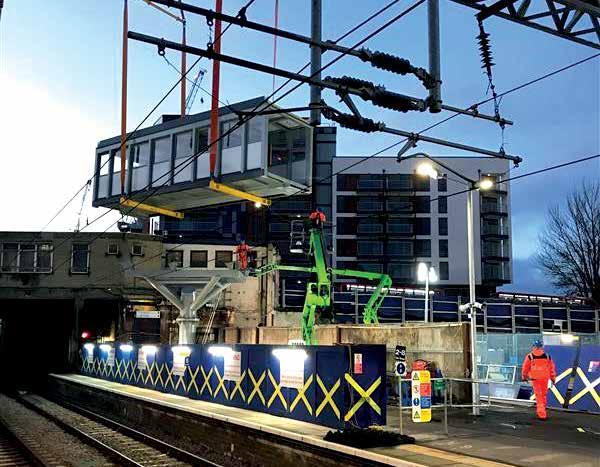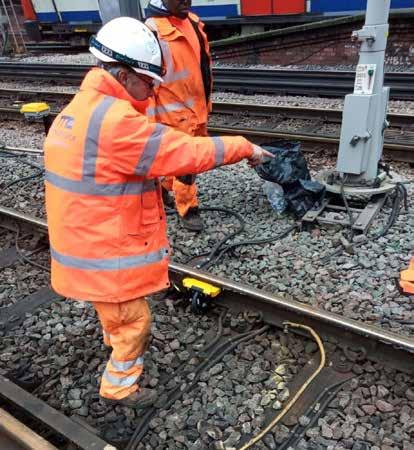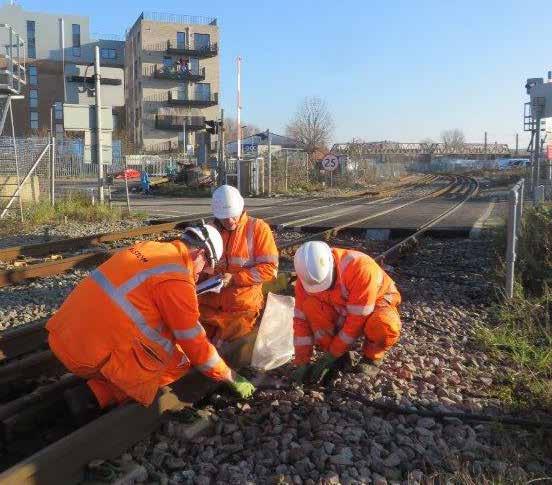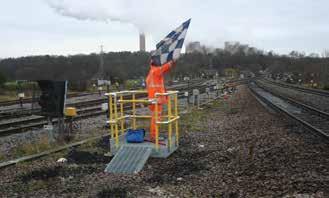
10 minute read
A Great (Western) Christmas
One of the many projects that took place over the Christmas period involved the Great Western main line between London and Slough. There was no major headline project, but the opportunity of the twoday train service shutdown was taken to do some important renewal and enhancement work. Some disruption to train services before and after was inevitable but this was kept to a minimum.
A variety of work took place. Trackwork was renewed, overhead electrification lines were remodelled, signalling systems were enhanced and stations were upgraded.
This one article attempts to draw all of these individual works together, the common link being that they were all carried out on the Great Western route out of Paddington, which, as a result, was closed from 24 to 27 December and offered a reduced service from 28 to 31 December.
Track and crossing renewal
Southall East junction, at the London end of the station, has a ladder junction enabling trains to cross from Up Main to Up Relief or from Down Relief to Down Main, as well as permitting crossover movements between the various lines as and when required.
The Christmas renewal involved the switches between the two relief lines, part of an ongoing project which commenced in Christmas 2018, at which time half of the junction was renewed. This year, the third quarter was added to the project, with the remaining quarter being planned for just before Christmas 2020. A conversation with the project manager – Sarah Fraser – who works in the Network Rail track renewals office at Bristol revealed all.
Rail Engineer | Issue 181 | Jan/Feb 2020 Essentially, this was a like-for-like renewal, so it was relatively easy to implement. The relief lines are maintained for 90mph running, with the ladder junction allowing 70mph crossing movements. Hence, the pointwork stretches over a considerable distance. It required an all-line possession (because of overhead electrification work – see next section) from 01:30 on Christmas Eve through to 04:00 on 28 December and then possession of the relief and main lines in turn from 28-31 December, which allowed a reduced train service to operate with a full timetable being restored on New Year’s Day.



The new ‘G’ switches, with NR56 rail profile, were assembled in the ‘Westinghouse’ sidings to the west of the station and then moved to site by PEM/LEM machines, itself a considerable task. Once the old pointwork had been removed, the normal 300mm dig took place for new ballast to be laid whence the new switches could be positioned. New point machines were installed, which were in-bearer clamplocks, with hy-drive in view of the switch length, with everything being connected up and tested ready for normal running.
Like all projects of this nature, much effort in planning and implementing the work was required. The switch design was carried out by AECOM from its Swindon office with the principal contractor being Colas Rail UK, working out of premises near to Birmingham. Much of the rail mounted plant was supplied by Colas Rail including tampers, the track relaying machines (TRM) and the PEM/LEM equipment. Readypower supplied the road-rail vehicles (RRVs) and much of the other heavy plant.
The project formed part of the South Rail Systems Alliance contract under the control of the Network Rail’s Bristol office. The cost of the track work was in the order of £2 million. All went to plan and handback was on time.
Overhead Line Electrification (OLE) resilience
When electrification of the line to Heathrow Airport took place in the 1990s, the favoured configuration was the headspan method, as this was a cheaper solution compared to the portal structures that had been used hitherto. A headspan consists of two substantial stanchions, one either side of the multi-track running lines, connected by suspension wires from which the power catenaries are installed.
Whilst elegant and less visually intrusive, it has the disadvantage that, if a train damages any one catenary, this can lead to a collapse of the entire span, thus causing power to be lost to all tracks and considerable damage to all of the overhead wiring. Train service disruption can be considerable with lengthy times being needed to restore the OLE wiring and normal operation.
The highest risk of damage being caused is at switch and crossing locations, where the overhead wiring is more complex through the junctions. For these reasons, and also the higher speed of traction (125mph for the Class 800 trains), it was decided that all the junctions (Acton West, Southall East & West and Stockley) would be tangentially wired, so the opportunity of the Christmas possession was taken to improve the resilience of the OLE infrastructure. To achieve this, a change from headspan to cantilever structures was engineered, these being simple stanchions associated with only one line and typically used on double or single-track railways. New stanchions had been installed in the weeks leading up to Christmas. The revised design involved splitting the catenary runs into three parts and, once the possession was taken, the existing headspan wiring was removed, hence the need to have access to all tracks. The whole junction area has been re-wired in this manner, but was organised so as to allow two-track operation from 28 December.
Station upgrades
With the introduction of the Class 345 Crossrail trains, some platform lengthening was required, which was completed by 1 November. However, station improvements continue to be made and at Christmas, considerable work was carried out at Hayes & Harlington and at Ealing Broadway.
Transforming the Market by Turning Our Customers’ Wishes Into Reality Approved Replacements for Legacy Rectifiers & Transformers
Economy Range
• Zero Inrush & Insulated to 3kV • Full Certification Class II • Hybrid Rectifiers & Transformers • Eco friendly and High Efficiency

CLASS II HYBRID RATINGS 250va 500va 1kva 1.4kva 2kva 3kva
• Zero Inrush & Insulated to 20kV • Patented Insulated Coating (GB2496062) • Full Certification Class II • Hybrid Rectifiers & Transformers
Insulated Range CLASS II HYBRID RATINGS 2 x 5ADC 2 x 8ADC 1 x 10ADC
At Hayes & Harlington, a new footbridge, including some of the stairways, was lifted in by two 500-tonne road-mounted cranes - one located on the north side of the station, the other on the south. Clearly, this work took advantage of the all-track possession and the spans were lifted in successfully during the four-day allline blockade. The footbridge is now in use over the relief lines except for access to the down fast platform, which still has to be completed. Disabled access by lift is part of the project, but these are not ready yet.
Ealing Broadway is being significantly modernised to handle growing passenger numbers, with a new concourse being constructed. Part of the work at Christmas was to put a scaffold cap over part of the existing buildings in readiness for their demolition. Additionally, steelwork was installed for new canopies on Platform 4, which required small cranes to be deployed on the platform. Although this was a relatively small part of the whole station upgrade, it was clearly sensible to take advantage of the track possession.
Axle counters
Another significant project that took place on the Great Western main line over Christmas was to replace the track circuits between Paddington and Slough (just over 14 miles) with axle counters.
Now under the control of the Thames Valley Signalling Centre, the track circuits (types TI21/EB2100 and RT Reed) have been becoming increasingly unreliable, so Network Rail decided that a change in train detection technology needed to be undertaken. It is a big project, with around 770 axle counters required in total, and will take many months to complete.
Structural Precast for Railways


Rail Engineer | Issue 181 | Jan/Feb 2020 Alstom engineers installed 208 axle counters in four days.

Alstom has been awarded the early works contract and is doing all the design work from its Derby office. They have chosen to use the Frauscher axle counter, which has the advantage of being clamped to the rail rather than needing the rail to be drilled. It is a product already deployed in a number of Network Rail locations so its performance is well understood.
Work is currently at the stage where the axle counters are being installed, along with their associated cabling run back to a disconnection box at the trackside. This is a time-critical element as it requires technicians to be working on the running lines, which cannot be achieved without a possession.
Advantage was taken of the Christmas 2019 possessions to carry out this important work over the period from Boxing Day (Dec 26) through to Dec 30. In total some 208 axle counters were installed in that time.
The most difficult section is the multi-track railway for two miles out of Paddington, where access is always problematic. Alstom assembled teams of 24 people, supported on site by Network Rail engineers, who worked a single shift each day so as to take advantage of daylight hours.
Installing the axle counters is relatively straightforward, but the cable to carry the power and data counts once the counter is active is more difficult. Cleating to the underside of the running rails is now the preferred method of installing and securing cables transversely across tracks. Once in position and cleated, the cables are terminated in a lineside termination box known as a generator junction box (in German: Generatorenanschlusskasten – or GAK). This termination box, between the axle counter cable and the lineside cabling, is positioned adjacent to the cable troughing and some 38 GAKs were installed over the period.

Kwik-Step Modular Platforms and Stairways
The first two days of the full possession were used to install the axle counters on all tracks where the London Underground Hammersmith & City lines are adjacent, as access is even more hazardous in this section, with the latter two days concentrating on the two relief lines.
Alstom had also undertaken design work for the Crossrail West junction and had produced the GRIP 3 (option selection) plans for this. Being involved at an early stage enabled a logical progression to GRIP 4 (single option development). Everything went well over the Christmas 2019 period, but clearly the work is far from finished with another 500+ axle counters still to be installed and cabled. Of course, similar access will be required when the time comes for the testing of the new installations, to validate the positioning of previously installed axle counters, set up the axle-counter heads and positively correspond each detection point to an evaluator, the interlocking and the control system. As the plan is to introduce all 770 new axle counters at the same time, commissioning will be a huge task requiring dedicated installation and test teams. It is planned for Christmas 2021, so no doubt will form part of next year’s Rail Engineer Christmas review.
Thanks for help with this article to Sarah Fraser (track), Ewen Morrison (stations), Richard Whinnett and James Greatbanks (OLE) of Network Rail and to Andy King and Will Roberts from Alstom, who made the point that the co-operation between Alstom, Network Rail and Frauscher engineers has been exemplary.

Lightweight FRP Minimal Groundwork Simple Assembly Available from Stock

Lookout Posts & Refuges
Minimal Groundwork Simple Assembly Use Immediately Range from 12° to 45° Available from Stock

Galvanized Steel Stairways
www.kwik-step.com











